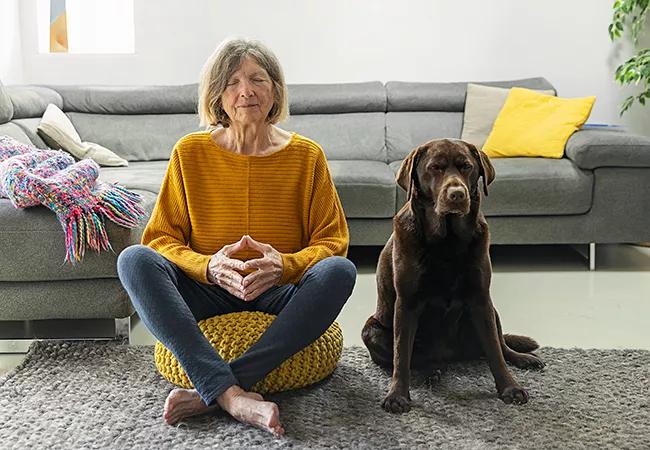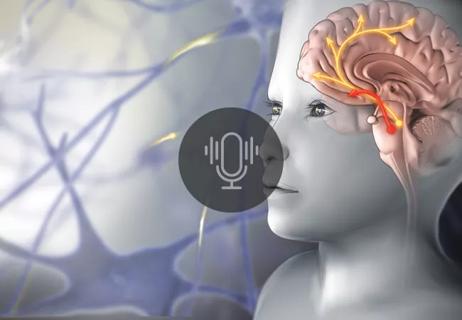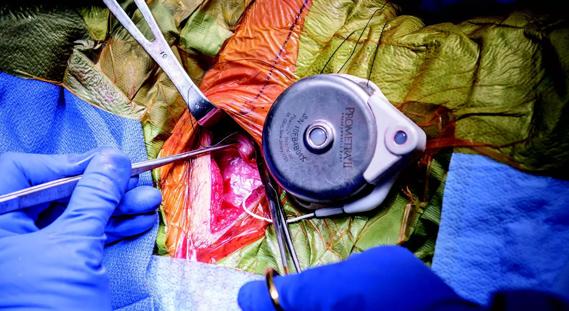Two-hour training helps patients expand skills that return a sense of control

Patients with chronic pain often lose control over significant parts of their lives. They can feel helpless against intolerable discomfort, and be unable to work, connect with loved ones or take part in previously enjoyed activities. Simple activities such as bathing and getting dressed may be beyond their capabilities on some days.
Now Cleveland Clinic pain management specialists are connecting patients to a single-session, two-hour group education program to give them more tools for managing. The hope is not simply to interrupt the downward spiral that often characterizes chronic pain, but to kickstart an upward trajectory that restores some function and a sense of control.
Advertisement
Cleveland Clinic is a non-profit academic medical center. Advertising on our site helps support our mission. We do not endorse non-Cleveland Clinic products or services. Policy
“Chronicity, whether it’s pain or illness or disease or injury, starts to affect your whole life,” says Jill Mushkat Conomy, PhD, a psychologist in Cleveland Clinic’s Pain Management department. “I love to see people able to return to a functional lifestyle – who tell me they’re going out with family again or they’re going back to work.”
Nonpharmacologic tools, including psychotherapy, are long-established for helping patients with their pain, but for a variety of reasons, not everyone has the ability or willingness to see a therapist. In 2013, Beth Darnall, PhD, director of the Pain Relief Innovations Lab at Stanford University, developed Empowered Relief® to quickly connect patients with skills to help cope with pain.
Delivered by clinicians who must be certified to deliver the instruction, the program incorporates pain education, mindfulness, techniques for cognitive reframing, relaxation and self-soothing. A clinical trial funded by the National Institutes of Health found that the program delivered pain reduction equal to eight sessions (16 hours) of cognitive behavioral therapy for patients with chronic low back pain.
In 2018, Cleveland Clinic introduced the program in some patient populations, and the health system’s Spine Center has embraced it perioperatively for individuals experiencing acute pain related to spine surgery.
In fall 2023, Dr. Mushkat began offering Empowered Relief for patients with chronic pain.
“There are people who will not come for psychological interventions but who may be willing to participate in a two-hour program that gives them some education about managing pain,” says Dr. Mushkat. “A lot of information can be consolidated into a two-hour program. And afterward, if someone feels that they would like individual therapy sessions, that is available to them.”
Advertisement
The biopsychosocial model holds that pain is influenced by biological, psychological and social factors, and that loss of control takes an enormous psychological toll. Mitigating that loss is part of the work of pain psychologists, says Dr. Mushkat. “The focus becomes how to help people go from ‘I can’t do anything I used to do,’ to ‘Here’s what I want to do. How can I do it? How can I achieve it?’ And this is captured in Empowered Relief.”
The Centers for Disease Control and Prevention estimates that in 2019, nearly 21% of U.S. adults (51.6 million people) experienced chronic pain; nearly 7% experienced “high-impact chronic pain” – meaning that it’s significant enough to curtail daily activities.
“There are a lot of people with pain who function well on a daily basis, who may be working but might benefit from acquiring extra skills for managing,” Dr. Mushkat says. “And there are other people who just don’t know what’s happening to them. Chronic pain has changed their whole life. They can’t do the things they used to do.”
The group aspect of Empowered Relief can help patients feel less alone. Dr. Mushkat encourages clinicians who have patients going through therapy to include them in Empowered Relief if those patients are likely to benefit. They can contribute to the group dynamic by sharing their experience of overcoming skepticism toward certain pain management skills that have helped them.
In addition to the in-person class experience, participants leave with a slide deck so they can review the content. They also have access to a guided relaxation recording that uses auditory tones to help reduce tension.
Advertisement
“When you have pain, you tense up, and then you become more anxious. As you become more tense, you have more pain. And it goes both ways,” says Dr. Mushkat. “It’s important to try to break that cycle by developing exercise or relaxation skills that you can keep in your toolkit.”
While not all pain can be completely eradicated, adding techniques that address the psychological side of pain can help patients to function just better enough so that they can add more activities to their lives.
“For patients with chronic pain, no one treatment or intervention will work all the time,” says Dr. Mushkat. “That’s why it’s necessary for them to have a number of things that they can turn to. If they have an injection and can only move their arm one way, maybe we can get them a little more relief so that it’s possible to work the arm more. Then after the next injection, they can get it a little farther and begin to restore range of motion.”
Increasing function is the goal. “We want to give patients control of their lives by giving them skills in addition to their treatments,” says Dr. Mushkat. “No one wants to be totally dependent on an injection to feel better. They want to be able to make the decisions for themselves. That’s when ‘Can I get up and do this today?’ becomes ‘how can I get up and do this today?’”
Advertisement
Advertisement

Researchers seek solutions to siloed care, missed diagnoses and limited access to trauma-informed therapies

Cleveland Clinic study investigated standard regimen

Researchers identify the neurologic evolution of pain-related learning

Tapping into motivational interviewing to guide behavioral change

Self-efficacy mindset, burst therapy and increased biofeedback may help improve outcomes

How functional restoration can help children with these conditions marked by unexplained pain with stigmatized symptoms

National Institutes of Health grant supports Cleveland Clinic study of first mechanism-guided therapy for CRPS

New technologies and tools offer hope for fuller understanding